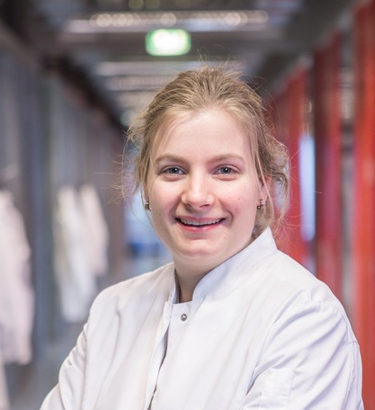Mix and match - new monomers for interfacial polymerization
Evelien Maaskant is a PhD student in the research group Inorganic Membranes. Her supervisor is prof.dr.ir. N.E. Benes from the faculty of Science and Technology.
 Interfacial polymerization is a very versatile technique that allows for the production of thin, defect-free films in a localized manner. These films can be used as membranes for, e.g., gas separation, reverse osmosis, or nanofiltration. Interfacial polymerization allows for the use of a large variety of monomers, and therefore a virtually unlimited amount of possible networks could be designed. This thesis focuses on the synthesis of new materials prepared by interfacial polymerization by incorporating new monomers.
Interfacial polymerization is a very versatile technique that allows for the production of thin, defect-free films in a localized manner. These films can be used as membranes for, e.g., gas separation, reverse osmosis, or nanofiltration. Interfacial polymerization allows for the use of a large variety of monomers, and therefore a virtually unlimited amount of possible networks could be designed. This thesis focuses on the synthesis of new materials prepared by interfacial polymerization by incorporating new monomers.
The thesis starts with an overview of interfacial polymerization and the influence of its reaction parameters based on the well-studied classical polyamide chemistry. This is followed by a section focusing on the possibilities of new monomers that could be used within interfacial polymerization.
In the subsequent chapter, a newly synthesized polyamide thin film composite membrane has been reported based on a star-shaped trifunctional acyl chloride monomer. The membrane performance was compared to that of conventional polyamide membranes.
The remainder of the thesis report on the preparation of non-polyamide networks. First, the synthesis of hybrid poly(PDMS-POSSimide) films by interfacial polymerization has been described. The poly(PDMS-POSSimide) films show, in comparison to conventional PDMS, a significant reduction in swelling in n-hexane and ethyl acetate vapor. However, a slightly enhanced swelling is observed in ethanol.
Secondly, the synthesis of thin (2-5 um) cyclomatrix polyphosphazene films has been described. These films have been prepared by the interfacial polymerization of hexachlorocyclotriphosphazene (HCCP) with an aromatic biphenol. Depending on the pKa1 and pKa2 of the biphenol, the cross-link density of the films can be altered. This difference in cross-link density is reflected in, e.g., surface morphology and mechanical properties of the resulting films.
Thirdly, a series of pH-stable poly(aryl ether) films has been described. The poly(aryl ether)s are prepared by the interfacial polymerization of cyanuric chloride (CC) with (fully) aromatic trialcohols. By eliminating the carbonyl bond that is present in the commonly used polyamide and polyester membranes, the stability of the membrane against extreme pH conditions could be enhanced. The poly(aryl ether)s are prepared by the interfacial polymerization of cyanuric chloride (CC) with (fully) aromatic trialcohols.
Finally, the synthesis of hyperbranched poly(aryl ether ketone)s (HBPAEKs) using a multifunctional monomer (AB2) approach has been described. This approach results in a HBPAEK with fluorine end-groups that can be modified to alter the properties of the polymer. In this thesis, the fluorine end-groups are partially replaced by 4-(phenylethynyl)phenol (PEP) end-groups, of which the alkyne moieties cross-link upon heating. The curing behavior and gas separation performance of HBPAEKs with and without PEP has been studied.
The subsequent chapter focuses on the preparation of a ceramic porous hollow fiber that is stable in harsh conditions and provides mechanical strength to a thin film prepared by interfacial polymerization. An alpha-alumina hollow fiber coated with gamma-alumina has been presented as support for the interfacial polymerization of piperazine and trimesoyl chloride.
The thesis finishes with reflections and perspectives on the results presented in the thesis. Additionally, suggestions for further research are given. The thesis ends with some general conclusions regarding the monomer functionality, the monomer reactivity and reaction conditions.





